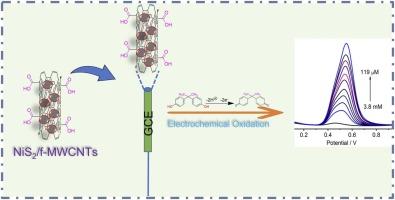Nanocarbon sensors: Unlocking efficient detection of water pollutants through electrocatalysis
IF 4.6
2区 农林科学
Q2 CHEMISTRY, APPLIED
引用次数: 0
Abstract
This study addresses the pressing issue of water contamination by developing a sensitive electrochemical sensor for bisphenol A (BPA) detection using a nanocomposite of Nickel disulfide (NiS₂) embedded in functionalized multi-walled carbon nanotubes (f-MWCNTs). The NiS₂/f-MWCNTs modified glassy carbon electrode (GCE) demonstrated a low limit of detection of 21 nM, surpassing some existing sensors and highlighting its potential for trace-level BPA detection. The sensor exhibited an enhancement in charge transfer kinetics compared to bare electrodes, attributed to the synergistic effects between NiS₂ and f-MWCNTs. With its high sensitivity and rapid response, this sensor shows promise for integration into handheld devices for on-site water testing, enabling efficient and accurate monitoring of BPA contamination. The proposed sensor's performance was validated through successful detection of BPA in real-world water samples, including milk, with recoveries ranging from 96.3 % to 99.50 %. This study demonstrates the potential of hybrid electrocatalysts in sensing applications, providing a promising approach for detecting environmental pollutants and ensuring water quality.

纳米碳传感器:通过电催化解锁水污染物的有效检测
本研究通过在功能化多壁碳纳米管(f-MWCNTs)中嵌入二硫化镍(NiS₂)纳米复合材料,开发了一种灵敏的双酚a (BPA)检测电化学传感器,解决了水污染的紧迫问题。NiS 2 /f-MWCNTs修饰的玻璃碳电极(GCE)的检测下限为21 nM,超过了现有的一些传感器,并突出了其痕量BPA检测的潜力。与裸电极相比,该传感器表现出电荷转移动力学的增强,这归因于NiS₂和f-MWCNTs之间的协同效应。凭借其高灵敏度和快速响应,该传感器有望集成到手持设备中进行现场水测试,从而有效准确地监测BPA污染。通过成功检测包括牛奶在内的实际水样中的BPA,验证了该传感器的性能,回收率为96.3% %至99.50% %。这项研究证明了混合电催化剂在传感应用中的潜力,为检测环境污染物和确保水质提供了一种有前途的方法。
本文章由计算机程序翻译,如有差异,请以英文原文为准。
求助全文
约1分钟内获得全文
求助全文
来源期刊

Journal of Food Composition and Analysis
工程技术-食品科技
CiteScore
6.20
自引率
11.60%
发文量
601
审稿时长
53 days
期刊介绍:
The Journal of Food Composition and Analysis publishes manuscripts on scientific aspects of data on the chemical composition of human foods, with particular emphasis on actual data on composition of foods; analytical methods; studies on the manipulation, storage, distribution and use of food composition data; and studies on the statistics, use and distribution of such data and data systems. The Journal''s basis is nutrient composition, with increasing emphasis on bioactive non-nutrient and anti-nutrient components. Papers must provide sufficient description of the food samples, analytical methods, quality control procedures and statistical treatments of the data to permit the end users of the food composition data to evaluate the appropriateness of such data in their projects.
The Journal does not publish papers on: microbiological compounds; sensory quality; aromatics/volatiles in food and wine; essential oils; organoleptic characteristics of food; physical properties; or clinical papers and pharmacology-related papers.
 求助内容:
求助内容: 应助结果提醒方式:
应助结果提醒方式:


